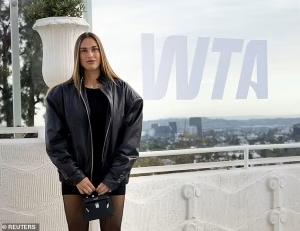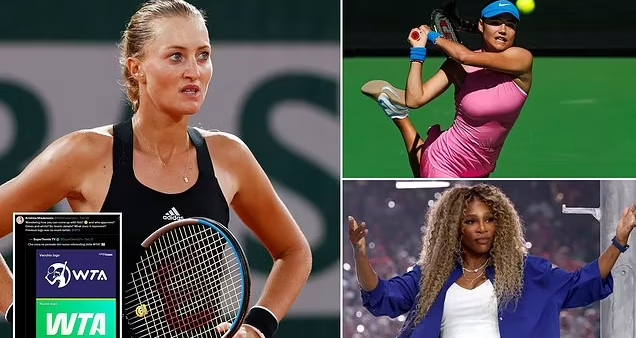They say there’s no such thing as bad publicity, which is perhaps just as well for the latest attempt to transform the image of women’s tennis.
The launch of a new logo for the Women’s Tennis Association, unveiled this week along with a revamped colour scheme and a fresh rallying cry, has occasioned much chatter among fans, with ‘ugly’, ‘boring’ and ‘horrible’ among the kinder verdicts.
Kristina Mladenovic, a former doubles world No 1 and winner of nine grand slam doubles titles, echoed the wider reaction on social media, questioning the rationale behind a change that has polarised opinion.
Wondering how you can come up with this and who approves?’ wrote Mladenovic, above a picture juxtaposing the new green logo with the previous purple version, which featured a player silhouette.
‘Green and white? No tennis details? What does it represent? Previous logo was so much better.’
It is certainly a departure from the earlier design, which debuted four years ago and was trumpeted as ‘a badge of pride and a reminder of the power of unity among strong individuals’.
But as any tennis player – or marketing executive, come to that – will tell you, results are all that matter, and in that respect the WTA is in the rudest of health.



In 2024, women’s tennis reached a record cumulative global audience of 1.1 billion on television and streaming platforms, a 10 percent increase on the previous year.
Prize money rose to an unprecedented £176 million, attendance figures went up 15 percent, and as of last October, the sport’s social media following stood at 6.3 million, a 26% year-on-year increase.
The WTA has been embroiled in a series of controversies recently, from the decision to stage last November’s flagship year-end finals in Saudi Arabia, a country with a troubled history on human rights, to the suspension of five-time grand slam champion Iga Swiatek over a failed drugs test the following month.
In January, Stefano Vukov, the coach of former Wimbledon champion Elena Rybakina, was suspended and subsequently banned over an alleged violation of the WTA’s code of conduct, while last month a man who followed Emma Raducanu across four countries was given a restraining order after exhibiting ‘fixated behaviour’ towards the former US Open winner.
Marina Storti, the chief executive of WTA Ventures, acknowledges that the path has not always been smooth since the autumn of 2023, when she took the helm of the WTA’s commercial arm, which was established earlier that year with the help of a $150 million (£119 million) investment from private equity firm CVC Capital Partners.
But against a background of what is now buoyant growth, the former Sky executive is understandably keen to accentuate the positives – a stance unlikely to be altered by a little online quibbling over logo aesthetics.
‘Every sport will face challenges, but I think it’s important that we don’t detract from the bigger picture,’ says Storti. ‘I think tennis is in incredible health. It’s been great to see audiences growing, attendances growing.
‘It’s also been great to see, particularly last year, that tennis is more and more at the forefront of culture.
‘To see, for example, our players on the red carpet with Zendaya and women’s tennis being featured on one of the top shows on Netflix [in the trailer for the series Emily in Paris]. We’re seeing our players on the covers of Vogue magazine in the US, China, Italy, all over the world, [and featured in] Forbes and Time.
The same can be said of both Coco Gauff, the American world No 3, and four-time major winner Naomi Osaka, both of whom have weighed in on subjects ranging from gun violence to women’s reproductive rights and racial injustice.
The Tunisian trailblazer Ons Jabeur, a former Wimbledon and US Open finalist, carries the hopes of a people, a country and a continent wherever she goes, having established a host of historic landmarks for Arab and African women.
And to the TikTok generation, Aryna Sabalenka may be better known for her dance moves and fashion preferences than as the world’s best tennis player.
Serena Williams, meanwhile, a 23-time grand slam champion who left the sport in 2022, underlined her enduring cultural relevance with a headline-grabbing dance cameo during Kendrick Lamar’s half-time Super Bowl turn last month.
The challenge, for a sport that struggles to reach beyond the boundaries of its existing fanbase outside major tournaments like Wimbledon, lies in persuading people to care about its stars on a year-round basis.
‘The big events create attention, but it’s about keeping the share of the audience, persuading those who engage once to be interested throughout the year,’ says Clifford Bloxham, a senior vice-president at leading global sports agency Octagon.
‘That would come with a superstar, definitely. You see that in football: in certain markets, people are beginning to follow the player rather than the club. I think tennis can be similar.
‘But when you talk globally, obviously you’re relying on the players to become global superstars.
